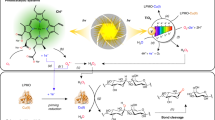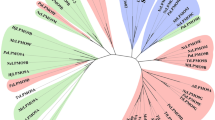Abstract
IT has been shown1 that when 1,4 polysaccharides, such as starch or cellulose, are treated with periodic acid solution, the carbon chain in each sugar unit is ruptured between carbon atoms 2 and 3, the —CHOH groups at these positions being oxidized to —CHO. Acid hydrolysis of these oxidized polysaccharides yields solutions containing glyoxal and erythrose. It has now been shown in this laboratory that aqueous solutions of periodic acid-oxidized starch or cellulose yield, when treated with phenylhydrazine acetate, a yellow amorphous precipitate. When the mixture is heated on the water-bath, glyoxalosazone is rapidly formed in crystalline condition. The glycosidic linkage, which is fairly resistant to acid hydrolysis, is thus readily opened by the phenylhydrazine reagent under mild conditions.
This is a preview of subscription content, access via your institution
Access options
Subscribe to this journal
Receive 51 print issues and online access
$199.00 per year
only $3.90 per issue
Buy this article
- Purchase on Springer Link
- Instant access to full article PDF
Prices may be subject to local taxes which are calculated during checkout
Similar content being viewed by others
References
Jackson and Hudson, J. Amer. Chem. Soc., 59, 2049 (1937); 60, 989 (1938).
Barry, J. Chem. Soc., 578 (1942).
Barry and Dillon, Proc. Roy. Irish Acad., 49, B 10, 177 (1943).
Author information
Authors and Affiliations
Rights and permissions
About this article
Cite this article
BARRY, V. Regulated Degradation of 1.3 Polysaccharides. Nature 152, 537–538 (1943). https://doi.org/10.1038/152537b0
Issue Date:
DOI: https://doi.org/10.1038/152537b0
This article is cited by
-
The apparent failure of sodium borohydride reduction to block further PAS reactivity in rat epithelial mucins
The Histochemical Journal (1977)
-
Formazan Reaction as a Confirmatory Test for Aldehyde Groups in Histochemistry
Nature (1964)
-
Application of New Methods of End-Group Determination to Structural Problems in the Polysaccharides
Nature (1945)
-
Action of Hydroxylamine on Polysaccharides Oxidized with Periodic Acid
Nature (1945)
Comments
By submitting a comment you agree to abide by our Terms and Community Guidelines. If you find something abusive or that does not comply with our terms or guidelines please flag it as inappropriate.



